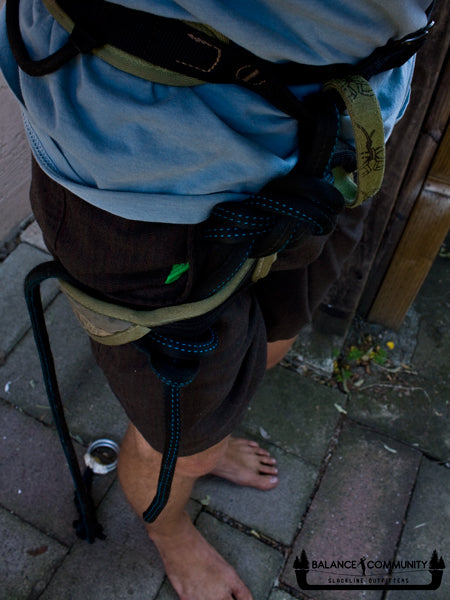You have no items in your shopping cart.
0
You have no items in your shopping cart.
First off, I would like to note that in no way is this article a complete guide to managing your leash while walking a highline. These are techniques that I use to ensure the leash stays out of my way and they may not work for some people. The best way to get comfortable with your leash is to walk highlines as often as you can.
Also, most of these techniques have to do with managing the leash so that leash falls will not be bad. To prevent a leash fall in the first place, you should always try and grab the line first. I will go into catching technique in a later article.
Have you ever been on a highline and were not able to get comfortable with the leash? Well, there are a few techniques for managing the leash while you walk so that it doesn't get in the way.

Now you must make an important decision about what to do with your leash when walking. Do you want to walk with it in between your legs, or on one side of your body? I find that having the leash on one side of my body makes it much easier to deal with while walking. If you walk with the leash between your legs and you do not fall correctly, it can result in some very nasty leash falls. Likewise with having the leash on one side of you, if you fall wrong, you can take a bad leash fall. This is why it's important to choose which one feels most comfortable to you.
If you choose to walk with the leash on one side of you, you should try and put it on the side of your body that is opposite of the side you normally fall off of a slackline. For instance, when you are slacklining in the park, what side of the line is most comfortable for you to fall off on? I usually fall off on the left side of the line, so I put my leash on my right side. In most cases, your leash falls will be the most comfortable if you fall off the side you normally do on a lowline with the leash on the opposite side. The reason for this is because all of your limbs will be away from the leash while you are falling.
Now, you will probably notice that the leash will not want to stay on one side of your body unless it's held there. A good technique to keep it out of the way of your feet while you are walking and hold it on the side is to take the backup knot that you tie with the tail of the knot going to your harness and tuck it in your leg loop, as in the picture. I usually tuck the knot in the leg loop such that the tail from this knot is all the way through the leg loop (note this in the picture). I've never had this come out while walking or even doing tricks.
If you choose to walk with your leash between your legs, you need to learn how to fall correctly. To take a leash fall with the leash between your legs, it is best to do sort of a front flip off the line while holding on to the knot at your harness. Otherwise, your legs are very likely to get caught in the leash while you fall and cause you to do a crazy spinning whipper. These can sometimes be very painful. My suggestion would be to learn to fall correctly with this leash method before attempting any walking.
One advantage to having the leash between your legs is that it can be much shorter, which makes it much easier to climb after a leash fall. It's also easier to do some tricks with the leash between your legs.
That covers this article on Walking with the Leash. Next up is how to climb your leash after a leash fall, and then catching technique. Please feel free to ask any questions below in the comments section.
| Product | Price | Quantity | Options | |||||
|---|---|---|---|---|---|---|---|---|
| Features |
| Availability: |
| Price |
| Options |
| Actions |

← Older Post Newer Post →
0 comments